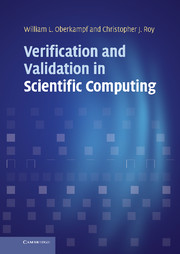Book contents
1 - Introduction
Published online by Cambridge University Press: 05 March 2013
Summary
This chapter briefly sketches the historical beginnings of modeling and simulation (M&S). Although claiming the beginning of anything is simply a matter of convenience, we will start with the stunning invention of calculus. We then discuss how the steadily increasing performance and decreasing costs of computing have been another critical driver in advancing M&S. Contributors to the credibility of M&S are discussed, and the preliminary concepts of verification and validation are mentioned. We close the chapter with an outline of the book and suggest how the book might be used by students and professionals.
Historical and modern role of modeling and simulation
Historical role of modeling and simulation
For centuries, the primary method for designing an engineered system has been to improve the successful design of an existing system incrementally. During and after the system was built, it would be gradually tested in a number of ways. The first tests would usually be done during the building process in order to begin to understand the characteristics and responses of the new system. This new system was commonly a change in the old system's geometrical character, materials, fastening techniques, or assembly techniques, or a combination of all of these changes. If the system was intended to be used in some new environment such as a longer bridge span, a taller structure, or propelled at higher speeds, the system was always tested first in environments where the experience base already existed. Often, during the building and testing process, design or assembly weaknesses and flaws were discovered and modifications to the system were made. Sometimes a catastrophic failure of a monumental project would occur and the process would start over: occasionally after attending the funeral of the previous chief designer and his apprentices (DeCamp, 1995). In ancient times, chief designers understood the consequences of a major design failure; they had skin in the game.
- Type
- Chapter
- Information
- Verification and Validation in Scientific Computing , pp. 1 - 18Publisher: Cambridge University PressPrint publication year: 2010



